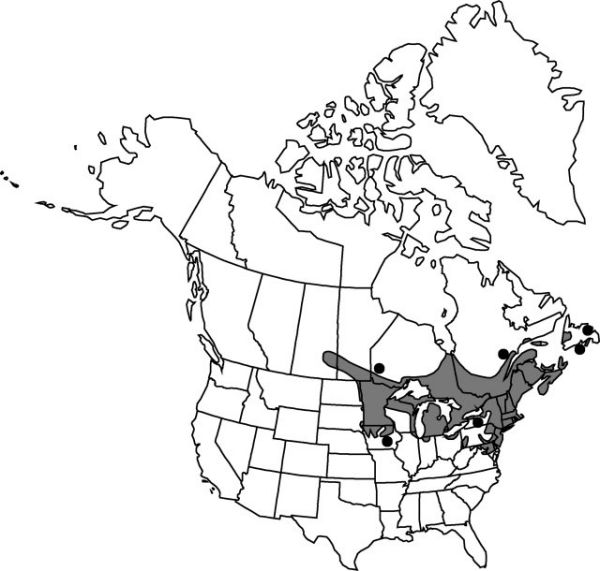Trillium cernuum
Sp. Pl. 1: 339. 1753.
Rhizomes short, thick. Scapes 1–2 (–3), round in cross-section, 1.5–4+ dm, slender, glabrous. Bracts often overlapping, sessile or with a barely noticeable, petiolelike base, umbrellalike; blade bright green without red tones, broadly rhombic-ovate to suborbicular, 5–15 × 6–15+ cm, base attenuate, apex acuminate. Flower usually hidden beneath bracts, nodding, odorless; sepals spreading, green, lanceolate-ovate, 9–30 mm, slightly shorter than to equaling petals, margins slightly raised, apex acuminate; petals usually strongly recurved from above base, extending behind plane of sepal bases for more than 1/2 their length, white or rarely pale-pink, adaxial veins not conspicuous, oblong-lanceolate, 1.5–2.5 × 0.9–1.5 cm, thin-textured, margins entire, apex acuminate; stamens ± straight, 6–15 mm, shorter than pistil, slender; filaments white, ± equaling anthers, slender; anthers straight, pale lavender-pink or gray, 2–6.5 mm, dehiscence introrse to latrorse; ovary prominent, white to pinkish, pyramidal, strongly 6-angled, 3–12 × 3–10 mm, widest above basal attachment; stigmas erect, recurved, distinct, white, not lobed adaxially, 3–8 mm, widest at base, fleshy, basally thickened, gradually tapered; pedicel strongly recurved or declined below or angled between bracts, 1.5–3 cm. Fruits dark red, with fruity fragrance, ovoid, to 3 cm diam., fleshy, juicy. 2n = 10.
Phenology: Flowering spring–summer (Apr–Jul).
Habitat: Rich, mostly deciduous forest southward, mixed deciduous-coniferous forests, swamps, moist coniferous forests northward
Elevation: 30–600 m
Distribution

St. Pierre and Miquelon, Man., N.B., Nfld. and Labr. (Nfld.), N.S., Ont., P.E.I., Que., Sask., Conn., Del., D.C., Ill., Ind., Iowa, Maine, Md., Mass., Mich., Minn., N.H., N.J., N.Y., N.Dak., Ohio, Pa., R.I., S.Dak., Vt., Va., W.Va., Wis.
Discussion
Previous authors commonly recognized var. cernuum and var. macranthum, based primarily upon size differences. Plants attributed to var. cernuum are found from Delaware and eastern Pennsylvania northward to Newfoundland, while those attributed to var. macranthum are found mainly farther inland into the Midwest. Although there is a tendency for the eastern seaboard plants to be somewhat smaller and more delicate, and the midwestern and far northern plants to be more robust, there is much variation, largely dependent on soil nutrients. There are regional size trends, but based on my observations of this species in Newfoundland, Michigan, Wisconsin, and Minnesota, I do not believe that the two varieties can be maintained.
In the Gray Herbarium, there is a collection by Richardson labeled “Mackenzie River,” which has been cited by H. M. Raup (1947) and others. W. J. Hooker ([1829–]1833–1840) reported Trillium cernuum “from Saskatchewan to Mackenzie River.” Raup stated that “it is the only evidence for the occurrence of...Trillium in the entire Mackenzie Basin.” Other writers have simply quoted that statement. In view of the relatively great disjunction from the known Saskatchewan stations and in the absence of any other supporting specimens from that area, I believe that there might be locality error on the Richardson sheet. However, it is not beyond possibility that T. cernuum could occur there. This apparent disjunct station is not mapped here.
Selected References
None.
Lower Taxa
"broad" is not a number."compressed-shortened" is not a number. "elongated" is not a number."thick" is not a number."dm" is not declared as a valid unit of measurement for this property."thicker" is not a number."widest" is not a number.